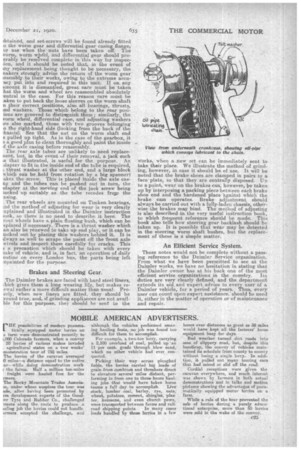MOBILE AMERICAN ADVERTISERS.
Page 23

If you've noticed an error in this article please click here to report it so we can fix it.
rpossibilities of modern pneurriatically equipped motor lorries on
e farm were demonstrated recently to i,000 Colorado farmers, when a convoy 20 lorries of various makes invaded . agricultural states on a two weeks' roorrstration tour of 750 miles. •
The lorries of the caravan averaged mile;s—a distance equal to the entire_ • ur—while .doing demonstration work
the farms. Ralf a million ton-miles freight were hauled free for the rmers.
The Rocky Mountain Trades ..kasocia311, under whose auspices the tour was ads, after having been promoted by rm development experts of the Good!sr Tyre and Rubber Co., challenged =era along the route to prodnce oiling job the lorries could not handle. trmers accepted . the challenge, and.. although the vehicles performed af118,2, lug hauling feats, no job was found Leo difficult for them to accomplish.
For example, a two-ton lorry, carrying a 2,100 overload of coal, pulled up'an II per cent. grade through blow sand, which no the vehicle had ever con. quered.
Picking their way across ploughed fields, the lorries carried big loads of grain from combines and threshers direct to elevators several miles distant, performing in from one to three hours herding jobs that would have taken horse
teamsa full day to accomplish. Live stock, lumber coal, barley, rye, oats, wheat, potatoes, cement, shingles, plaster, kerosene, and even church pews, were transported between farms arid railroad shipping points.In many cases loads handled by these lorries in a few
hours over distances as.great asUl miles would have kept all the farmers' horse equipment busy for days.
Bad weather turned dirt roads into seas of slippery mud, but, despite this handicap, the convoy of vehicles maintained its schedule from county to county without losing a single lorry. In addition, it pulled out many touring cars that had mired or slid off the road: Cordial receptions were given the caravan everywhere, and much interest was shown by farmers in both actual demonstrations and in talks and motion pictures showing the advantages of pneumatically equipped 'meter lorries on a farm.
While a rule of the tour prevented the sale of lorries during a purely educcetional enterprise, more than SO lorries were sold in the wake of the convoy.
































